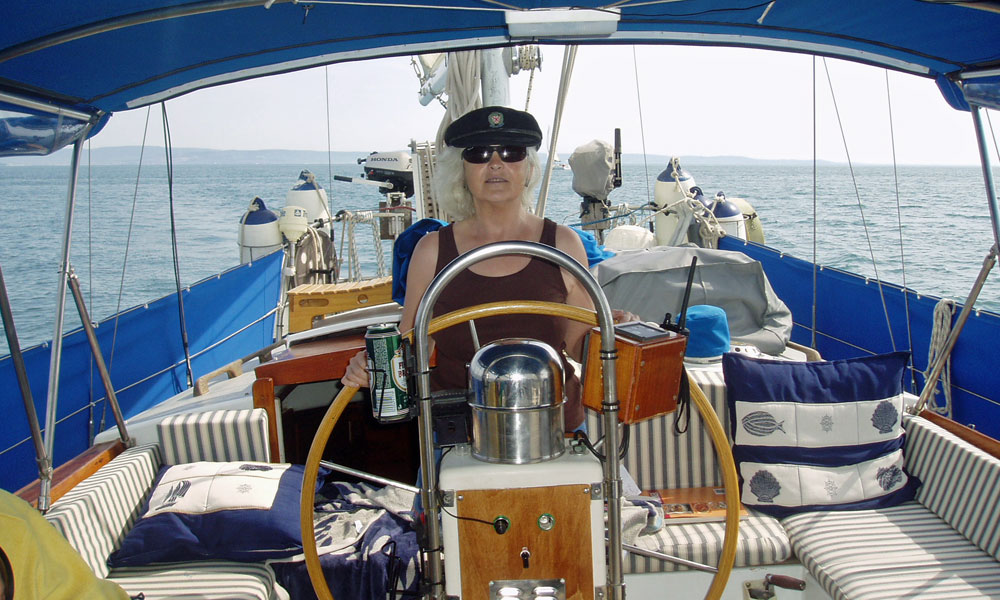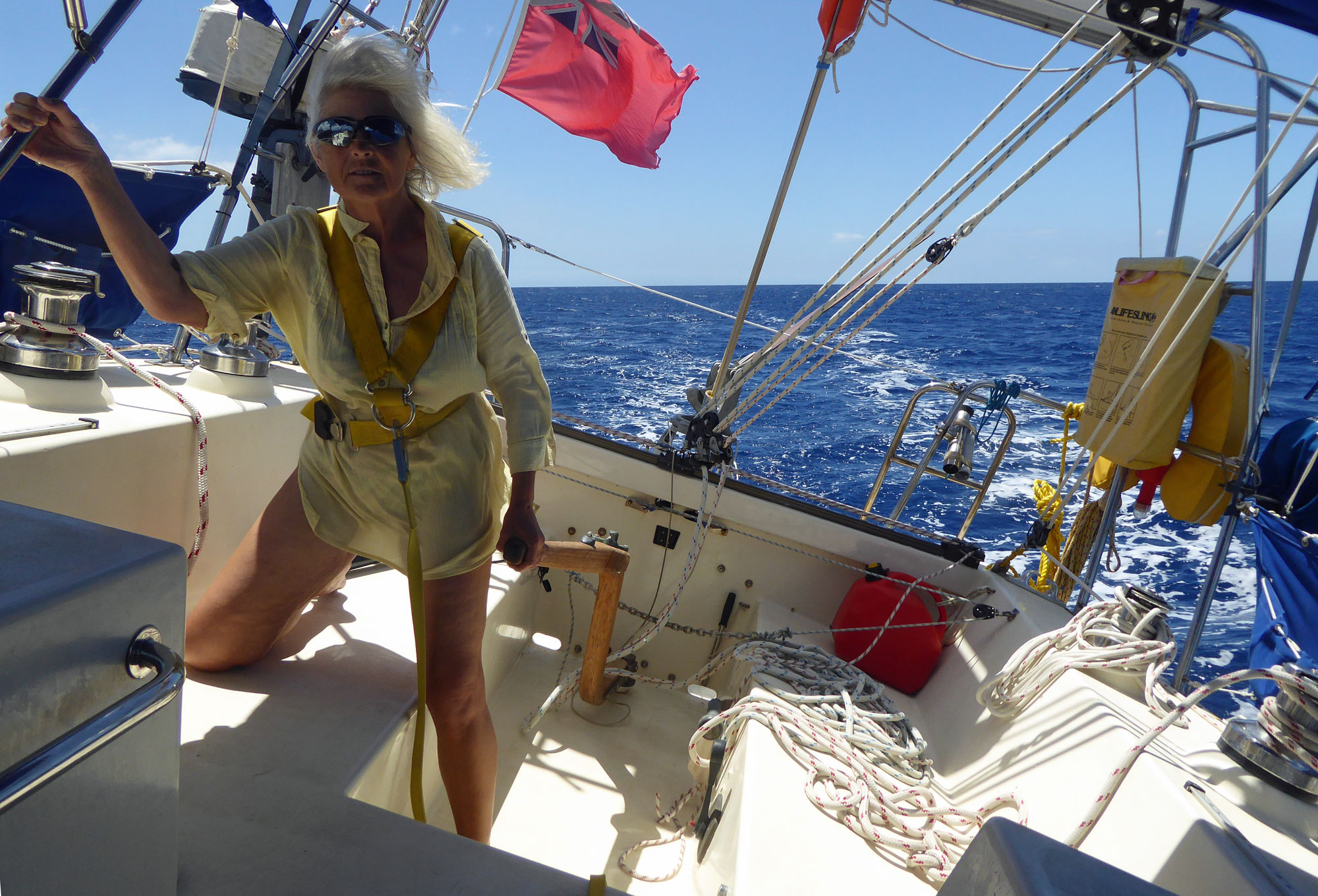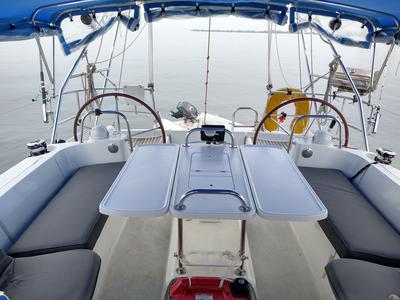- Home
- Parts of a Sailboat
- Sailboat Tillers
Sailboat Tillers versus Wheel Steering
I'm a big fan of sailboat tillers and I have a question:
"Just who told the marketing men that we all want to steer our boats with wheels?"
Admittedly, centre cockpit designs have to be wheel steered owing to the distance between the helming position and the rudder. And so do large heavy displacement designs where the tiller would need to be inconveniently long.
 On a heavy-displacement, centre-cockpit sailboat like this Whitby 42, wheel steering is the only option
On a heavy-displacement, centre-cockpit sailboat like this Whitby 42, wheel steering is the only optionBut for most moderate-displacement, aft-cockpit designs under 45 feet (14m) or so a sailboat tiller often makes more sense, and is much more fun to use.
Nothing beats sitting out on the coaming with a tiller extension helming the boat like a large dinghy. Well, for a while anyway - gone are the days when I'd do this for hour after hour!
When we built Alacazam, a boat which responds enthusiastically to this kind of involvement, we positioned the primary and secondary winches a bum-width apart for this very purpose.
Strangely, over the years, these winches have got closer together...
 Mary at the helm of Alacazam, our light-displacement, aft-cockpit cruiser. Maybe a tad too much weather helm, Mary? Perhaps drop the mainsheet car down the track a little? And perhaps I should have tidied up the sheets before taking the photograph...
Mary at the helm of Alacazam, our light-displacement, aft-cockpit cruiser. Maybe a tad too much weather helm, Mary? Perhaps drop the mainsheet car down the track a little? And perhaps I should have tidied up the sheets before taking the photograph...Twin Wheels, anyone?
I could almost understand a case for twin wheels if it offered redundancy in the event of linkage failure, but in most cases it doesn't. Both wheels usually share the same linkage; so if it fails, they both fail.
 Two wheels in this aft-cockpit 44 footer! But why?
Two wheels in this aft-cockpit 44 footer! But why?I can understand the need for twin wheels on a wide-sterned racing yacht, but in a more conventionally proportioned cruising boat, to me, it doesn't make a lot of sense. It can only be a fashion thing...
Comparison of Sailboat Tillers and Wheels
So having confessed my preference for tiller steering, perhaps I should explain myself...
A tiller...
- takes up less space in the cockpit than a wheel;
- through its direct attachment to the rudder, rewards the helmsman with ultimate feel and feedback;
- by virtue of its mechanical simplicity ensures reliability and robustness;
- allows the helmsman, steering with the tiller between his legs, trim the jib, mainsheet and - if he's really brave - the spinnaker, without disturbing the offwatch crew;
- works well with both windvane servo-pendulum self-steering gears and electronic autopilots;
- allows the helmsman to gain shelter from the sprayhood;
- at anchor can be lifted up out of the way, leaving the cockpit clear;
However...
- It can't be geared down to make high steering loads manageable;
- and it can be tiring to hold for long periods of time, especially in strong winds or rough seas. You may need to use an extension handle, an autopilot, or a self-steering system to reduce fatigue;
- and it can limit your visibility of the sails, the instruments, or the horizon, depending on where you sit in relation to the tiller. You may need to move around frequently or rely on other crew members to check these aspects;
- and a tiller can be awkward to use in tight spaces, such as marinas or docks, where you may need to make quick and precise maneuvers. You may need to practice reversing or turning with a tiller before attempting these situations.
Whereas a wheel...
- can be geared down to make high steering loads manageable;
- positions the helmsman right aft, denying him any protection from the sprayhood;
- in most cases, doesn't allow the helmsman to trim the sails on his own;
- is less precise than a tiller, offers the helmsman little feedback;
- requires an expensive and complicated linkage arrangement of wires and blocks which, without regular maintenance, is prone to failure;
- is awkward to link to both windvane self-steering gears and electronic autopilots, and
- adds weight right aft, just where you need it least;
- clutters up the cockpit when at anchor;
- is more complex and expensive to install and maintain than a tiller, which may require cables, pulleys, gears, or hydraulics;
But...
- a wheel does allow you to sit or stand in different positions in the cockpit, which can improve your visibility of the sails, the instruments, or the horizon.
A convincing case for a tiller? Well, that's really for you to decide, but pointedly, all wheel steered boats have - or should have - an emergency tiller, which may tell us something.
Fashion has a lot to answer for!
Tiller vs Wheel Steering: A Few FAQs...
How do you set up self-steering with a sheet-to-tiller system on a sailboat?
How do you set up self-steering with a sheet-to-tiller system on a sailboat?
A sheet-to-tiller system is a way of using the jib sheet and some bungee cords or surgical tubing to steer the boat without holding the tiller. The basic principle is that when the boat veers off course, the jib sheet will pull or slacken the tiller, which will correct the course. To set up this system, you need to do the following steps:
- Trim the jib sheet through its usual leeward block, then run it to a block on the windward side of the cockpit beside the tiller;
- Attach one end of a bungee cord or surgical tubing to the leeward side of the cockpit near the stern, then run it through another block near the end of the tiller and back to itself. This will create tension on the leeward side of the tiller;
- Tie one end of a short cord (about 9 or 10 feet) to the jib sheet near where it exits from its leeward block, then run it through another block near where it enters its windward block. Tie the other end of this cord to an eyelet or cleat on top of the tiller. This will create tension on the windward side of the tiller;
- Adjust the tension of both sides of the tiller until they are balanced and keep the boat on course. You may need to experiment with different lengths and elasticities of bungee cords or surgical tubing until you find what works best for your boat.
How do you lock the tiller on a sailboat?
How do you lock the tiller on a sailboat?
Locking the tiller on a sailboat can be useful when you need to leave the helm for a short time, such as adjusting the sails, checking the charts, or using the head. There are different ways to lock the tiller, depending on your boat and equipment. Some common methods are:
- Using a tiller lock or clamp that attaches to the tiller and the cockpit sole or coaming. This will hold the tiller in place and prevent it from moving. You can adjust the tension of the lock or clamp to allow some play or movement of the tiller if needed;
- Using a tiller tamer or brake that attaches to the tiller and a line that runs through two blocks on either side of the cockpit. This will create friction on the tiller and slow down its movement. You can adjust the tension of the line to control how much resistance the tiller has;
- Using a bungee cord or surgical tubing that attaches to the tiller and two points on either side of the cockpit, such as cleats, stanchions, or lifelines. This will create tension on the tiller and keep it centred. You can adjust the length and elasticity of the bungee cord or surgical tubing to allow some movement of the tiller if needed.
How do you set up an autopilot with a wheel steering system on a sailboat?
How do you set up an autopilot with a wheel steering system on a sailboat?
An autopilot is a device that can steer the boat without human intervention, based on a pre-set course or data from sensors. To set up an autopilot with a wheel steering system on a sailboat, you need to do the following steps:
- Choose an autopilot that is compatible with your boat size, type, and steering system. There are different types of autopilots, such as cockpit-mounted, below-deck-mounted, hydraulic, electric, or wind-powered;
- Install the autopilot components, such as the control unit, display unit, drive unit, compass sensor, wind sensor, speed sensor, and GPS receiver. Follow the manufacturer's instructions and wiring diagrams carefully;
- Calibrate and test the autopilot for accuracy and performance. You may need to adjust some settings, such as rudder gain, counter rudder, response level, and off-course alarm.
The above answers were drafted by sailboat-cruising.com using GPT-4 (OpenAI’s large-scale language-generation model) as a research assistant to develop source material; to the best of our knowledge, we believe them to be accurate.
Recent Articles
-
Wauquiez Gladiateur 33 for Sale
Apr 10, 24 05:40 AM
'Kesh', my Wauquiez Gladiateur 33 is only for sale because we've decided to go for a larger sailboat. She currently berthed in Florida, USA. -
'Cabo Frio', a Catalina Morgan 43 for sale
Apr 01, 24 08:35 AM
This Catalina Morgan 43 is for sale at a very reasonable price. She offers up to 7 berths in 2 cabins + saloon. There is full 6'5" standing headroom and good ventilation throughout. -
Live Aboard Boats For Sale
Mar 30, 24 07:02 PM
Ready to live the dream? Then browsing through this listing of live aboard boats for sale might just get you on your way...












